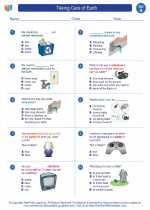Taking Care of Earth -> velocity
Velocity
Velocity is a measurement of the rate and direction of motion of an object. It is a vector quantity, which means it has both magnitude and direction. Velocity is different from speed, which is a scalar quantity and only measures the magnitude of motion.
Calculating Velocity
The formula for calculating velocity is:
Velocity (v) = Displacement (Δx) / Time (Δt)
Units of Velocity
Velocity is typically measured in meters per second (m/s) or kilometers per hour (km/h) for everyday use. In scientific contexts, it may also be measured in other units such as feet per second, miles per hour, or even in terms of the speed of light (c).
Understanding Velocity
Velocity can be positive, negative, or zero, depending on the direction of motion. A positive velocity indicates motion in one direction, while a negative velocity indicates motion in the opposite direction. Zero velocity means the object is not moving.
Velocity Study Guide
- Definition: Velocity is the measurement of the rate and direction of motion of an object.
- Formula: Velocity (v) = Displacement (Δx) / Time (Δt)
- Units: Meters per second (m/s) or kilometers per hour (km/h)
- Direction: Velocity is a vector quantity, so it includes information about the direction of motion.
- Comparison with Speed: Velocity differs from speed in that it includes the direction of motion, whereas speed only measures the magnitude of motion.
[Velocity] Related Worksheets and Study Guides:
.◂Science Worksheets and Study Guides First Grade. Taking Care of Earth

 Worksheet/Answer key
Worksheet/Answer key
 Worksheet/Answer key
Worksheet/Answer key
 Worksheet/Answer key
Worksheet/Answer key
 Vocabulary/Answer key
Vocabulary/Answer key
 Vocabulary/Answer key
Vocabulary/Answer key
